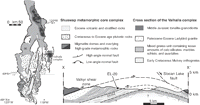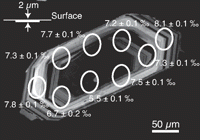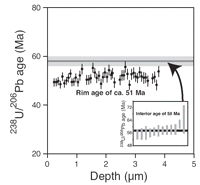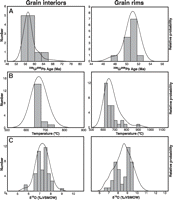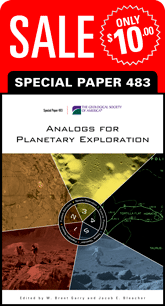Fluid-rock interaction in orogenic crust tracked by zircon depth profiling
+ Author Affiliations
Abstract
Ion microprobe U-Pb, δ18O, and Ti depth profiling analyses of natural zircon rims permit unprecedented assessment of the relationship between timing, temperature, and geochemical environment during crystallization and cooling of deep orogenic crust. Zircon from migmatite in a deeply exhumed gneiss dome in the Valhalla metamorphic core complex, southeast British Columbia, Canada, records the timing of melt crystallization and subsequent fluid-rock interaction before the final stages of extension and exhumation. Zircon interiors reveal a weighted mean age of 58 ± 2 Ma, interpreted as the timing of melt crystallization. Depth profiling U-Pb measurements of unpolished zircon rims yield an age of 51 ± 2 Ma over 4 μm. Ti-in-zircon thermometry indicates 650 °C for both rim and interior, confirming that the complex remained at high temperature during zircon crystallization. Previous δ18O measurements suggest that high-temperature fluids with δ18O of ~10‰ pervasively infiltrated the complex. The oxygen zircon results clearly resolve a δ18O contrast between zircon interiors (7.2 ± 0.2‰) and rims (8.4 ± 0.2‰). The lighter interior δ18O values indicate the timing of melt crystallization and equilibration of the rims with melt at 58 Ma ago. Alternatively, δ18O values from the 51 Ma rims match the composition predicted (8.4‰) from fluid interaction based upon previous work. Integrating the age and δ18O results reveals that amphibolite facies fluid-rock interaction persisted until final rapid exhumation of the Valhalla complex. The results further indicate the power of using the ion microprobe to track the timing of fluid infiltration in the crust as well as the effect of fluid infiltration on the subgrain scale.
INTRODUCTION
Fluid-rock interactions strongly influence partial melting, rock deformation, and metamorphic processes during orogeny (e.g., Newton, 1989; Morrison and Anderson, 1998; Manning and Ingebritsen, 1999; Baxter, 2003). Fluids are especially important because their circulation may strongly influence the thermal and mechanical behavior of the system. The relative timing of fluid-rock interaction during metamorphism and magmatism is generally resolved from field-based relative timing relationships such as those involving veins or metasomatic zones (e.g., Bebout and Barton, 1989). The absolute timing can be determined if a geologic feature created by or affected by fluid-rock interaction can be directly dated by radiogenic isotope methods. However, this can be a challenging task in high-grade metamorphic terrains where robust geochronometers such as zircon are generally highly resistant to recrystallization, even during melt-generating reactions (Harrison and Watson, 1983; Watson, 1996). Characteristically, new zircon crystallization during amphibolite facies metamorphism is minimal and expressed by micrometer-scale overgrowths (e.g., Williams, 2001; Corfu et al., 2003). Resolving such a record thus requires high spatial resolution (e.g., Zeitler and Williams, 1988; Mojzsis and Harrison, 2002). Previous studies have used the ion microprobe in depth profiling mode to achieve the submicrometer-scale spatial resolution required to analyze ultrathin zircon rims that crystallized in response to fluid interactions (e.g., Carson et al., 2002; Breeding et al., 2004). In this study, we go further by integrating U-Pb age, Ti geothermometry, and oxygen isotope depth profiling of zircon rims to better understand timing, metamorphic conditions, and geochemistry of fluid-rock interaction in orogenic crust during the final stages of extension and gneiss dome crystallization in a metamorphic core complex (MCC).
GEOLOGIC BACKGROUND
The Valhalla complex is a gneiss dome located within the Shuswap MCC, southeast British Columbia (Fig. 1) (Reesor, 1965; Carr et al., 1987). The complex exposes migmatitic gneisses and granitoid that achieved conditions of 820 °C and 8 kbar (Spear and Parrish, 1996). Metamorphism occurred from ca. 85 to 58 Ma ago and culminated in a ca. 62–58 Ma episode of granitoid emplacement and partial melt crystallization (Carr et al., 1987; Parrish et al., 1988; Parrish, 1995; Spear and Parrish, 1996; Gordon et al., 2008). The Valhalla gneiss dome was exhumed to upper crustal levels (T < 300 °C) by 50–47 Ma ago (Parrish et al., 1988; Gordon et al., 2008).
Simplified geologic map of the Shuswap metamorphic core complex, revealing the series of gneiss domes including Frenchman Cap (FC), Thor-Odin (TO), Valhalla complex, and Okanogan-Kettle complex (OC) (after Kruckenberg et al., 2008). A cross section through the Valhalla complex is also shown, illustrating the main lithologic units and location of the studied sample. GCSZ—Gwillim Creek shear zone (after Schaubs et al., 2002).
Holk and Taylor (2007) concluded that two dominant modes of hydrothermal activity characterized the Valhalla complex: (1) an early system involving circulation of magmatic and/or metamorphic, heavy-δ18O waters at lithostatic pressures and low water/rock ratios within the high-grade rocks; and (2) overprinting shallow-level convective circulation of surface-derived, lighter-δ18O waters at hydrostatic pressures and at high water/rock ratios (see also Magaritz and Taylor, 1976, 1986). To evaluate the timing, physiochemical conditions, and consequences of fluid-rock interaction in the migmatitic rocks of the gneiss dome, we measured U-Pb age, δ18O compositions, and Ti-in-zircon paleotemperatures from the outer rims of zircons from a migmatitic biotite gneiss (sample EL-20) by secondary ion mass spectrometry (SIMS) depth profiling using the University of California–Los Angeles (UCLA) ims1270 ion microprobe (Mojzsis and Harrison, 2002; Carson et al., 2002; Breeding et al., 2004). For each type of analysis (i.e., U-Pb, O, and Ti), measurements were obtained from subjacent volumes in different analysis sessions. Further details are presented in the GSA Data Repository.1 Zircons selected from EL-20 were clear, euhedral, tabular crystals that do not reveal distinct rims in cathodoluminescence images (Fig. 2), but rather exhibit simple oscillatory zoning.
RESULTS
We performed SIMS U-Pb age depth profiling measurements into the natural (unpolished) outer surfaces of 13 zircons from EL-20 and obtained a consistent 238U/206Pb age of ca. 51 ± 2 Ma over sputter pits that varied in depth from 3.7 to 4.5 μm (Figs. 3 and 4A). The results do not show any evidence for discordance (see the GSA Data Repository). After depth profiling analyses, the grains were polished and reanalyzed in conventional spot analysis mode. Twelve of 14 analyses from the zircon interiors yield a weighted average 238U/206Pb age of 57.5 ± 2.6 Ma (MSWD = 1.8; Figs. 3 and 4A), representing the timing of melt crystallization. This is ~6 Ma older than the rim values and is similar to the melt crystallization ages yielded by zircon from other migmatites throughout the gneiss dome (Gordon et al., 2008).
238U/206Pb age versus depth plot for an EL-20 zircon revealing the variation in age as the ion probe beam sputtered into the crystal. The dark gray bar surrounded by the light grey box across the age versus depth plot represents the age and error obtained through conventional polished analyses from the interior of the grain. The inset is a weighted mean age figure for the conventional polished analyses.
Relative probability diagrams for both the unpolished rims and the interiors of the grains. A: U-Pb measurements. B: Ti-in-zircon thermometry. C: δ18O measurements.
To better determine the conditions in which zircon rim growth/recrystallization occurred, we have applied the Ti-in-zircon thermometer (Watson et al., 2006; Ferry and Watson, 2007) to both the rims and interiors of EL-20 zircon crystals. Rutile and quartz are both present in EL-20. Crystallization temperatures calculated from the depth profiling data, assuming Ti and Si activity equal to 1, range from 620 to 795 °C with the majority of the analyses clustering around 650 °C (n = 25; Fig. 4B). The temperatures are equivalent to the results obtained from the conventionally sectioned and polished interiors from the same sample (644–725 °C; n = 17; Fig. 4B).
The δ18O values measured from the rims yield a weighted mean δ18O of 8.4 ± 0.2‰ (n = 46; MSWD = 2.0; Fig. 4C) with values up to 9.5 ± 0.7‰. These values are significantly higher than the δ18O results measured from the interiors of the zircon grains in spot analysis mode, which yield a weighted mean δ18O of 7.2 ± 0.1‰ (n = 45; MSWD = 3.2; Figs. 2 and 4C), reflecting equilibration with the melt. Detailed spot mapping of δ18O from one EL-20 zircon confirms that rims are heavier in δ18O relative to the zircon interiors (Fig. 2), but even the highest rim values in spot mode fall ~0.3‰ short of the average rim values acquired in depth profiling mode. It is possible that δ18O spot values of the grain are averaging over growth zones with different isotopic compositions.
INTERPRETATION
The zircon rims with the elevated δ18O values formed in the presence of an external mobile phase (melt or aqueous fluid). Variable Th-Pb ages (ca. 58–50 Ma) obtained from patchily zoned monazite from EL-20 and throughout the Valhalla complex (Gordon et al., 2008) are consistent with Eocene fluid-mediated recrystallization (see Townsend et al., 2001; Ayers et al., 2006). Our results indicate that zircon rim recrystallization/growth was also triggered by infiltration of aqueous fluid. Isochemical remelting or a continuous molten state for EL-20 zircon cannot explain the contrast in δ18O from ca. 58 to 51 Ma ago given constant temperature as indicated by the Ti-in-zircon thermometry. Fluid infiltration can, however, explain the contrast, and there is abundant evidence for it. Holk and Taylor (2000, 2007) reported relatively uniform quartz δ18O values of 11.2 ± 0.9‰ throughout the Valhalla complex, and they interpreted these results to reflect equilibration of the gneiss dome rocks with δ18O = 10‰ fluids exsolved from progressive crystallization of migmatites and metamorphic devolatilization. The ~8‰–9‰ δ18O values measured from the 51 Ma zircon rims match those predicted from the same pervasive fluids that produced the δ18O quartz values. Equilibrium oxygen isotopic fractionation between quartz and zircon as a function of temperature (Valley et al., 2003) predicts zircon δ18O values of 8.4‰ based on the quartz oxygen data. Further measurements from additional samples yield equivalent results (Gordon et al., 2009).
In summary, U-Pb age, Ti thermometry, and δ18O results from the outermost several micrometers of sample EL-20 zircons indicate that high-temperature (~650 °C) magmatic and/or metamorphic fluids continued to infiltrate the migmatitic rocks of the Valhalla complex until the onset of rapid exhumation of the gneiss dome ca. 50–47 Ma ago (Parrish et al., 1988; Gordon et al., 2008) and are consistent with petrologic evidence from the Valhalla and other domes of the Shuswap MCC that indicates nearly isothermal decompression from upper amphibolite facies conditions (Duncan, 1984; Norlander et al., 2002; Marshall and Simandl, 2006).
DISCUSSION
Understanding the timing of fluid-rock interactions in orogenic crust in the context of timing, variability in physical and chemical conditions, and tectonic processes has long presented a great challenge (e.g., Parnell, 1998). Studies of core complexes have addressed the role that meteoric waters play in the thermal regime of detachment systems and have investigated how far surface-derived fluids have penetrated and exchanged with lower-plate rocks (e.g., Morrison, 1994; Morrison and Anderson, 1998; Holk and Taylor, 2007; Mulch et al., 2007; Person et al., 2007). Less is known about the thermal effects of the fluid regime (e.g., advective heat transport) at deeper levels of core complexes, in particular migmatite-cored core complexes that characterize the northern North American Cordillera as well as the Variscan orogen and many segments of the Alpine-Himalayan orogenic belt (Whitney et al., 2004).
In orogenic systems that have experienced a protracted high-temperature thermal and deformation history, evidence for late-stage metasomatic events can be impossible to detect using conventional geochemical methods. In this study, the combination of U-Pb age, Ti-in-zircon thermometry, and oxygen isotope analyses applied to a single mineral provides a comprehensive time-temperature-fluid data set for zircon crystallization and fluid-rock interaction in a core complex system. Depth profiling by SIMS is best suited for deciphering this record because of the minimal extent of recrystallization that takes place during high-grade metamorphism in largely stable, resistant phases such as zircon (e.g., Ayers et al., 2006). Previous studies employing SIMS U-Pb age depth profiling have demonstrated its value for understanding fluid infiltration during contact (Carson et al., 2002) and regional metamorphism (e.g., Breeding et al., 2004). Our study demonstrates the value of also undertaking Ti-in-zircon thermometry and δ18O compositional measurements from the outer natural surfaces of zircon to elucidate otherwise unattainable records of fluid history during regional metamorphism.
The fluids responsible for new zircon growth/recrystallization in the Valhalla complex could have been sourced from either continued metamorphic devolatilization of the migmatitic host rocks or heretofore unrecognized post–58 Ma crystallization of intrusions and partial melt emplaced at depths greater than those presently exposed within the complex. Other gneiss domes in the Shuswap MCC record granitoid emplacement and partial melt crystallization as young as ca. 50 Ma (Carr, 1992; Vanderhaeghe et al., 1999; Crowley et al., 2001; Hinchey et al., 2006; Kruckenberg et al., 2008). The absence of post–58 Ma plutons within the Valhalla complex may be attributed to its comparatively shallow structural level and its proximity to the cold foreland (Gordon et al., 2008). However, our new results are consistent with fluid being derived from metamorphism as well as from melt crystallization and granitoid emplacement within the deep portions of the Valhalla complex as late as ca. 51 Ma ago. This evidence for previously unrecognized magmatic activity at depth is important in that it helps explain how anomalously high-grade conditions (i.e., upper amphibolite facies conditions) could have persisted until rapid exhumation.
Acknowledgments
This research was supported by National Science Foundation (NSF) grant EAR-0409776 to D. Whitney and C. Teyssier and NSF grant EAR-0609911 to M. Grove. We thank J. Ayers and D. Foster for critical reviews of the paper. The ion microprobe facility at the University of California–Los Angeles is partly supported by a grant from the NSF's Instrumentation and Facilities Program, Division of Earth Sciences.
Footnotes
-
↵1GSA Data Repository item 2009177, details of analytical methods, is available online at www.geosociety.org/pubs/ft2009.htm, or on request from editing@geosociety.org or Documents Secretary, GSA, P.O. Box 9140, Boulder, CO 80301, USA.
- Received 23 October 2008.
- Revision received 12 March 2009.
- Accepted 30 March 2009.
- © 2009 Geological Society of America


